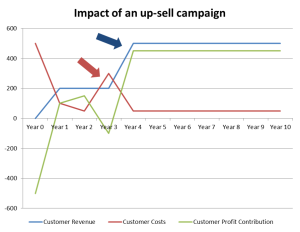Take Care When Calculating Average Customer Retention Cost
The retention cost formula seems to be straightforward, but average retention costs sometimes incorrectly due to using the wrong customer base number. It is not an uncommon for the calculation to be performed using the TOTAL numbers of customers, which would be incorrect.
Therefore, care needs to be taken when using the customer retention cost formula and we need to ensure that we only consider the number of customers RETAINED in the time period.
Retention cost formula
To calculate retention costs per customer you need to identify two components:
- Total retention costs incurred during the year (or other period applicable)
- And the number of customers retained in the following year (or other period)
Therefore, the retention cost formula is:
Total retention costs / by the number of customers retained
An example of the retention cost formula
If a firm spends $1 million on various retention costs during the year and it retained 10,000 customers, then it has spent an average of $100 per customer retention and up-selling during the year.
That is, $1m / 1o,000 = $100 per customer
Potential pitfalls of misusing the retention cost formula
Let’s use the same example as above; where the firm has spent $1 million on retention costs and has retained 10,000 customers. But let’s also assume that they have acquired 2,000 new customers during the year, growing their total customer base to now 12,000.
Given this information, there are three approaches to calculating this formula – with only one approach being the correct method to calculate the average customer retention cost.
- $1m (retention costs) /12,000 (total customer base) = $83 (INCORRECT)
- $1m (retention costs)/ 11,000 (average customer base in the year) = $91 (INCORRECT)
- $1m (retention costs)/ 10,000 (retained customers only) = $100 (CORRECT)
As you can see, selecting the wrong customer base metric, there is a real danger in understating average customer retention costs, which will probably make quite a significant difference in the final CLV number – which may lead to an over-investment in some marketing activities.
Up-selling campaigns are also part of retention costs in CLV
Do not be confused by the term “retention costs”. As per our marketing goals, we also want to grow customer revenues and share-of-customer. A firm will do this through a combination of: direct marketing, sales promotions, new products, price incentives, personal selling and so on.
These customer “up-sell” campaigns are also classified as retention costs in the customer lifetime value calculation. Probably the easiest way to think about is:
Retention costs are any marketing investments targeted at existing customers.
Up-selling campaigns should result in increased customer revenue
If a firm invests in a major up-selling marketing program, then it is likely that this will be reflected in increased customer revenues. Please refer to the following graph.
As you can see (red arrow), in year 3 there is a jump in customer retention costs, which is due to a major up-selling (or cross-selling) promotional campaign. This had the resultant effect of reducing the average customer profit contribution to a negative (loss) for that year.
However, this campaign was quite effective resulting in a major increase in customer revenues and profit contribution from year 4 onwards.
Average Retention Costs Should Be Lower Than Average Acquisition Costs
As a rough rule of thumb, retention costs are generally lower than average acquisition costs, as it is considered more cost-effective to retain an existing customer than to acquire a new one. Please review this Google books excerpt on the loyalty effect.
